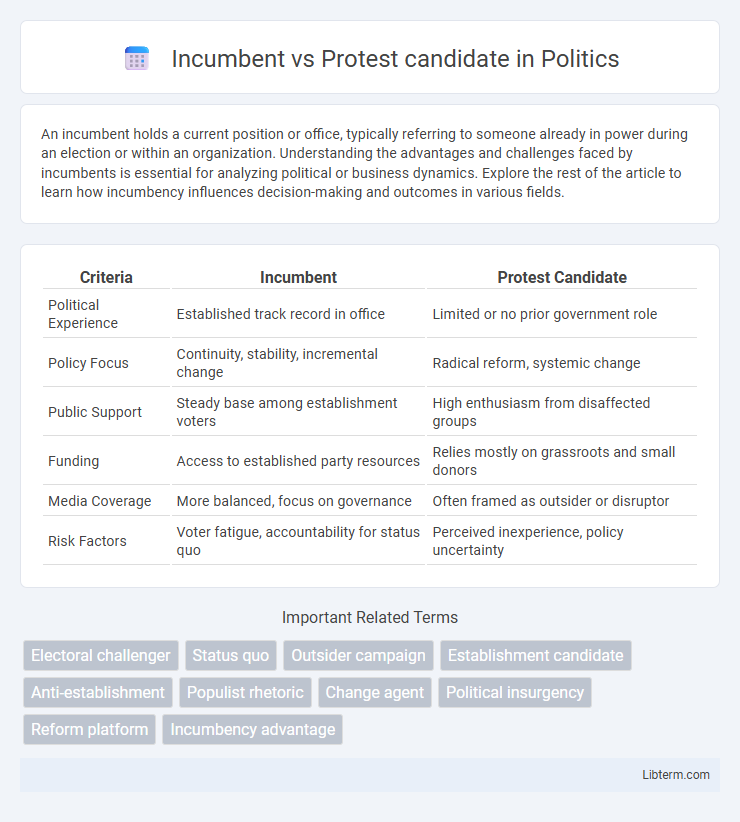An incumbent holds a current position or office, typically referring to someone already in power during an election or within an organization. Understanding the advantages and challenges faced by incumbents is essential for analyzing political or business dynamics. Explore the rest of the article to learn how incumbency influences decision-making and outcomes in various fields.
Table of Comparison
| Criteria | Incumbent | Protest Candidate |
|---|---|---|
| Political Experience | Established track record in office | Limited or no prior government role |
| Policy Focus | Continuity, stability, incremental change | Radical reform, systemic change |
| Public Support | Steady base among establishment voters | High enthusiasm from disaffected groups |
| Funding | Access to established party resources | Relies mostly on grassroots and small donors |
| Media Coverage | More balanced, focus on governance | Often framed as outsider or disruptor |
| Risk Factors | Voter fatigue, accountability for status quo | Perceived inexperience, policy uncertainty |
Understanding Incumbents: Definition and Role
Incumbents are current officeholders seeking re-election, typically benefiting from name recognition, established political networks, and access to campaign resources, which enhance their electoral advantage. Their role involves maintaining continuity in governance, leveraging their track record to appeal to voters, and influencing policy through established relationships within government institutions. Understanding the definition and role of incumbents is crucial for analyzing election dynamics and voter behavior.
Who is a Protest Candidate? Key Characteristics
A protest candidate emerges from widespread dissatisfaction with the political status quo, representing voices marginalized or ignored by mainstream parties. Key characteristics include minimal establishment support, reliance on grassroots mobilization, and often a platform centered on radical change or reform. These candidates challenge incumbents by highlighting systemic issues and advocating for alternatives to traditional policies.
Historical Trends: Incumbent vs Protest Candidate Elections
Historical trends in incumbent versus protest candidate elections reveal that incumbents often benefit from established political networks and greater resource access, leading to higher reelection rates. Protest candidates, typically emerging during periods of political unrest or dissatisfaction, leverage grassroots movements and anti-establishment sentiment to challenge the status quo. Data from multiple democracies shows that while incumbents win approximately 70% of elections, protest candidates gain significant traction during economic crises or corruption scandals, altering traditional voting patterns.
Motivations: Why Voters Choose Protest Candidates
Voters choose protest candidates to express dissatisfaction with the incumbent's performance and signal demand for change in governance or policy directions. Feelings of political alienation, unmet socioeconomic needs, and perceptions of corruption drive citizens toward candidates who promise reform or represent opposition to established power structures. This motivation is often heightened in contexts of economic downturn, social unrest, or perceived government ineffectiveness.
Incumbent Advantages: Resources and Recognition
Incumbent candidates benefit from substantial campaign resources, including established fundraising networks and access to media coverage that amplify their visibility. Their existing political recognition and name familiarity often result in higher voter trust and turnout. These advantages create significant barriers for protest candidates attempting to challenge the status quo in elections.
Challenges Faced by Protest Candidates
Protest candidates often confront significant challenges such as limited access to funding, reduced media coverage, and institutional barriers that favor incumbents. Voter skepticism and lack of established political networks further hinder their ability to gain traction. These obstacles make mobilizing grassroots support and achieving electoral success considerably more difficult for protest candidates.
Impact on Political Discourse and Policy
Incumbent candidates often shape political discourse by emphasizing their record and stability, while protest candidates challenge the status quo, highlighting issues neglected by mainstream parties. The presence of protest candidates can shift policy agendas, forcing incumbents to address emerging or controversial topics to retain voter support. This dynamic fosters a more diverse political debate and can lead to changes in legislation reflecting broader public concerns.
Media Coverage: Bias and Representation
Media coverage of incumbent candidates often emphasizes their experience and policy achievements, leading to a more favorable representation compared to protest candidates. Protest candidates typically receive less media attention, and when covered, the tone can be dismissive or skeptical, framing them as outsiders or fringe actors. This bias in media representation affects public perception and can limit the visibility and legitimacy of protest candidates in electoral contests.
Case Studies: Notable Incumbent vs Protest Candidate Contests
The 2000 U.S. Presidential Election highlighted the fierce contest between incumbent Bill Clinton's Vice President Al Gore and protest candidate Ralph Nader, whose Green Party campaign influenced key battleground states. In Brazil's 2018 election, incumbent Michel Temer's policies sparked opposition votes consolidating around Luiz Inacio Lula da Silva's protest candidacy, reshaping political alliances. South Korea's 2017 presidential race featured Moon Jae-in as an incumbent party candidate against Hong Joon-pyo, a protest candidate voicing anti-establishment sentiments, which mobilized younger voters and impacted election dynamics.
Future of Electoral Dynamics: What Lies Ahead
Incumbent candidates benefit from established political networks and name recognition, shaping voter trust and campaign resources in upcoming elections. Protest candidates often capitalize on public dissatisfaction, introducing disruptive platforms that challenge traditional power structures and force shifts in policy agendas. Future electoral dynamics will increasingly depend on how emerging social movements and digital engagement influence voter behavior and redefine political legitimacy.
Incumbent Infographic

 libterm.com
libterm.com